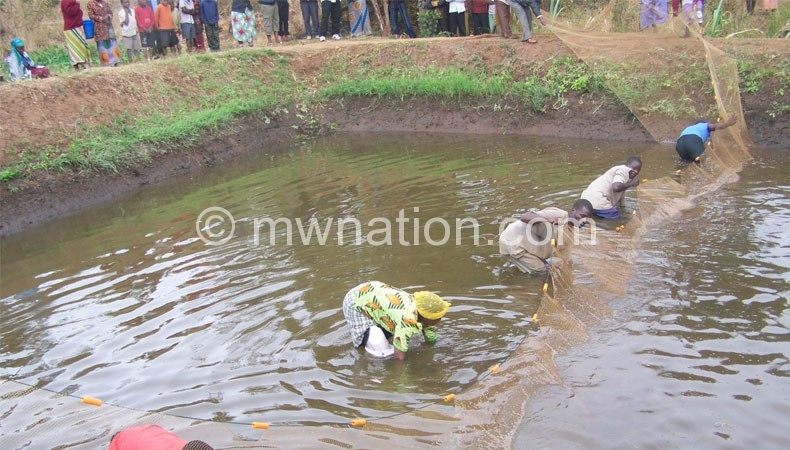Building resilience through fish farming
Fisheries and aquaculture are a vital sources of nutritious food, says the United Nations Food and Agriculture Organisation (FAO).
Yet their current production and supply is failing to meet the global demand in terms of nutrition requirements and sustaining the livelihoods of many.

In Malawi, the situation is not different.
For the past four decades, the animal protein supply from fish has tremendously decreased from 70 percent to less than 30 percent, according to the National Fisheries and Aquaculture Policy. Experts point to a number of factors that include rapid population growth and a decrease in fish stocks in most water bodies in the country.
Fish consumption is critical in enhancing dietary diversification and minimising micronutrient deficiencies in people.
Globally, more than one billion people obtain most of their animal protein from fish and 800 million depend on fisheries and aquaculture for their livelihoods, according to World Fish, an international organisation harnessing the potential of fisheries and aquaculture to human life.
But low production levels of fish make the acquisition of nutrition and sustainable livelihood unattainable. For Malawi, the increase in population—estimated at 17.4 million and accelerating at a growth rate of 2.3 percent—pushes up demand, thereby making the commodity scarce.
All is not lost though. There is hope of restoring and sustaining the constant supply of fish stocks through promotion of integrated small-scale fish farming. In Mchinji, some locals in Kaponya Village, Traditional Authority (T/A) Dambe have taken an initiative to make fish available in their area and surrounding communities through aquaculture.
With support from Local Development Fund (LDF) and Fisheries Department, members of Kaponya Cluster are now engaged in small-scale fish production. LDF provided financial support of about K6 million for digging five ponds while Fisheries office provided 3 500 fingerlings
High costs of fish and its scarcity in their locality is what motivated the group to take this route, said the cluster’s vice-chairperson Robert Molosoni.
Production of the fish is expected to enhance nutrition in households and improve the incomes of members in Kaponya Cluster.
“We are raising the fish primarily for business and consumption for our nutrition and health,” Molosoni said.
The first harvest is anticipated between July and August. Market prospects are there too, said Likisina Sikanadze, one of the women members for Kaponya.
Aquaculture and small-scale fisheries offer investment opportunities that respond to the impact of climate change and the people of Kaponya are looking forward to the same.
Experts say aquaculture in Malawi has potential for growth, but its development is often hampered by a number of key challenges that include access to quality commercial feeds.
This challenge is also prevalent in the practice of Kaponya Cluster, which only had access to commercial feeds for their fish at the beginning of their production.
“The fisheries office just provides a start-up. They say the feed is expensive and we resorted to use of maize bran,” said Charles Wilfred, bookkeeper for the cluster.
On average, the group spends about K1 500 a month in procuring the bran in times of plenty maize. But in lean periods, that amount goes twice as much, according to Wilfred.
Although the group is set to harvest the fish soon, it is yet to possess equipment for proper harvesting of the fish from their ponds.
But there is hope that the harvesting gear will be procured soon using the funds that the cluster generates through savings and loans among its members.
With the guidance of Community Savings and Investment Promotion (Comsip), members of Kaponya Cluster contribute monthly shares at a minimum of K1 000 as savings. Members also borrow money from the group’s savings and pay back with a 20 percent interest rate.
Currently, the cluster, which has 41 members (nine men and 32 women) has K1.6 million in savings and loans.
It is this financial power that gives the group the strength to sustain their fish production in terms of buying fishing gear, feeds and fingerlings in the future.
“We are encouraging members to buy more shares and borrow money from the cluster so that the income generated should be invested in this fish farming,” says Wilfred.
Environmental management in the area hosting the fish ponds is also key to the sustainability of their fish production. As such, the group is raising and managing a one-acre community forest to complement their fish farming in a swampy wetland.
“The forest is helpful in water retention in the catchment area, which is a critical resource to fish production,” said Wilfred adding that they established the forest in 2015 with 5 000 tree seedlings.
He said one of their five ponds dried up a year ago but the presence of the forest has ensured that water is always available in the remaining ponds.
Community development assistance for T/A Dambe Mike Katholi believes that the fish farming will improve the food security and nutritional status of most households in the area.
“The fish production will help to build community resilience to impacts of climate related shocks that often result in food insecurity,” Katholi said.





